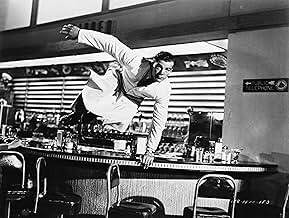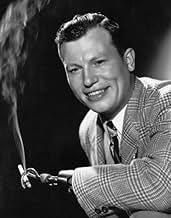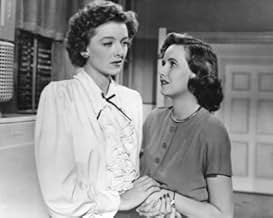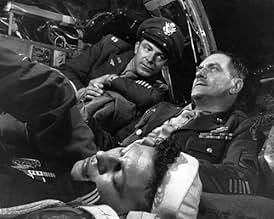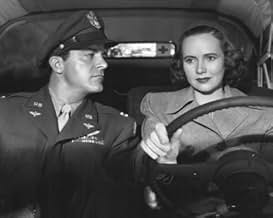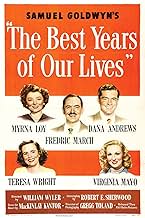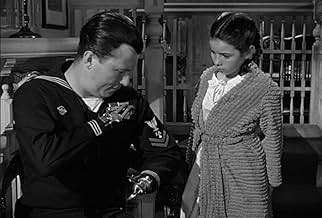Drei Veteranen kehren nach Ende des Zweiten Weltkriegs in eine amerikanische Kleinstadt zurück, wo sie entdecken, dass sie und ihre Familien sich unwiderruflich geändert haben.Drei Veteranen kehren nach Ende des Zweiten Weltkriegs in eine amerikanische Kleinstadt zurück, wo sie entdecken, dass sie und ihre Familien sich unwiderruflich geändert haben.Drei Veteranen kehren nach Ende des Zweiten Weltkriegs in eine amerikanische Kleinstadt zurück, wo sie entdecken, dass sie und ihre Familien sich unwiderruflich geändert haben.
- Regie
- Drehbuch
- Hauptbesetzung
- 7 Oscars gewonnen
- 25 Gewinne & 4 Nominierungen insgesamt
- Al Stephenson
- (as Frederic March)
Zusammenfassung
Empfohlene Bewertungen
Crafted with care, narrated with flair & incessantly human in its approach, William Wyler's film's silent, thoughtful contemplation on PTSD is still as relevant today as it was at its time of release. Firmly grounded in realism & having stood the test of time all these years, The Best Years of Our Lives is one of the finest offerings of its kind.
And while we don't often learn from history, we can be thankful that for once the United States of America did learn from what happened with its veterans after the previous World War. The GI Bill of Rights is mentioned in passing in The Best Years of Our Lives was possibly the greatest piece of social legislation from the last century. So many veterans did take advantage of it as do the veterans like Fredric March, Dana Andrews, and Harold Russell who you see here.
All three of those actors played archetypal veterans, characters that every corner of the USA could identify with. They all meet on an army transport plane flying to the home town of all of them, Boone City, Iowa.
War is a great leveler of class and distinction. Bank employee March, soda jerk Andrews, and high school football star Russell probably would never meet in real life even in a small town like Boone City. But they do meet and war forges indestructible bonds that can never be broken.
March is the oldest, a man with two children and Hollywood's perfect wife Myrna Loy. He settles in the first and the best. He has some wonderful scenes, getting cockeyed drunk on his return and later with a little bit of liquor in him, tells the bank officials at a banquet off in no uncertain terms.
I also love his scene where another returning veteran, a sharecropper wants to get a bank loan for his own piece of land. Watch March's expressions as he listens to the man's pitch for money. You can feel him read the man's soul. It's what got him his Second Best Actor Oscar for this film.
Harold Russell was a real veteran who lost both his hands during service in the Pacific. He got a special recognition Oscar for his performance. Because of that it was probably unfair to nominate him in the Supporting Actor category which he also won in. His performance, especially his scenes with Cathy O'Donnell as his sweetheart who loves him with or without his hands, is beyond anything that could be described as acting.
Dana Andrews is the only officer of the three, a bombardier in the Army Air Corps. Of the group of them, maybe he should have stayed in. He also comes from the poorest background of the group and he was an officer and a gentleman in that uniform. That uniform and those monthly allotment checks are what got Virginia Mayo interested enough to marry him. The problem is that he's considerably less in her eyes as a civilian.
While Mayo is fooling around with Steve Cochran, Andrews has the great good fortune to have March's daughter Teresa Wright take an interest in him. They're the main story of the film, Andrews adjustment to civilian life and adjusting to the fact he married the wrong woman. Not all veteran's problems were solved with GI Bill.
Myrna Loy gets little recognition for The Best Years of Our Lives. My guess is that it's because her role as wife was too much like the stereotypical wife roles she had patented over at MGM. Still as wife to March and mother to Wright she really is the glue that holds that family together.
The Best Years of Our Lives won for Best Picture for Sam Goldwyn, Best Director for William Wyler and a few others besides the two acting Oscars it got. It was a critical and popular success, possibly the best film Sam Goldwyn ever produced. It remains to this day an endearing and enduring classic and will be so for centuries. It's almost three hours in length, but never once will your interest wane.
The best tribute this film received came from Frank Capra who had a film of his own in the Oscar sweepstakes that year in several categories. In his memoirs he said that he was disappointed to be skunked at the Oscars that year, but that his friend and colleague William Wyler had created such a masterpiece he deserved every award he could get for it.
By the way, the film Capra had hopes for was It's A Wonderful Life. The Beat Years of Our Lives can't get better praise than that.
***** To me watching this movie is like opening up a time capsule. I think in many ways "The Best Years of Our Lives" is probably one of the more fascinating character studies and it holds up extremely well as a look at life in the US in the mid-1940s after WWII. I believe "Coming Home" and "The Deer Hunter", both released in 1978, were the most recent films that were closest in capturing the numerous issues of military men returning from war that were brought up in "The Best Years of Our Lives".
What really impressed me was watching the movie in its entirety when I was in college around 1980-81 and many if not all of the college students applauded at the end of the movie.
This movie still packs a wallop and I'm very happy to read in other posts other users feeling of a movie that will definitely stand the test of time. *****
I'm very happy to see the movie ranked near the top 100 movies on IMDb and AFI. Also, though it was in competition with what eventually became a Christmas classic, It's a Wonderful Life, arguably, The Best Years of Our Lives' Oscar wins, including Best Picture, were very well-deserved.
I've just seen the film again in 2005 and after almost 60 years, The Best Years of Our Lives is still a powerful, beautifully acted and well-crafted motion picture.
Back in 1946, it was a jaw-dropper to have a character in a movie utter the word "divorce" or to aver an intent to break up a marriage -- such ideas just weren't voiced in films then. To modern audiences, they come across as melodramatic, but I'm told they elcited genuine gasps from audiences then.
Even more astonishing was William Wyler's decision to cast real-life amputee Harold Russell in the key role of a returning Navy veteran. Until <i>The Battle of Britain</i>, in which an actual, disfigured RAF veteran made a cameo appearance, directors didn't make those sorts of courageous gestures. The intimate yet innocent scene in which Homer Parrish (Russell) demonstrates his helplessness to his fiancé Wilma Cameron (Cathy O'Donnell) is beautiful, heartbreaking and uplifting; later, during the wedding scene, Russell stumbled over a line in saying the vows, and Wyler left the humanizing mistake in, God bless him for it.
Such a powerful film. At first the new lives of the soldiers seem to be facing small adjustments, such as their children's interest in "atomic energy" and "scientific efficiency". But soon we find that jobs are hard to find, and the wives and girlfriends sometimes met new people while the battles were fought.
Although a serious topic, the film has the right balance of entertainment and drama. It never gets outright depressing, and things like depression and suicide are overlooked. But it still remains a valuable lesson: as bad as dying in the war is, sometimes the transition back to normalcy can be just as damaging.
Although not one of the better known movies today (2014), "The Best Years of Our Lives" won seven Academy Awards in 1946, including Best Picture, Best Director (William Wyler), Best Actor (Fredric March), Best Supporting Actor (Harold Russell), Best Film Editing (Daniel Mandell), Best Adapted Screenplay (Robert Sherwood), and Best Original Score (Hugo Friedhofer). It still sits on the IMDb Top 250, just as it should.
Oscars Best Picture Winners, Ranked
Oscars Best Picture Winners, Ranked
Wusstest du schon
- WissenswertesFor his performance as Homer Parrish, Harold Russell became the only actor to win two Academy Awards for the same role. The Academy Board of Governors thought he was a long shot to win, so they gave him an honorary award "for bringing hope and courage to his fellow veterans through his appearance." Later in the ceremony, he won for Best Supporting Actor.
- PatzerWhen Al introduces his wife and daughter to Fred and Homer at Butch's, he refers to Dana Andrews as Homer and Harold Russell as Fred. This was intended as a consequence of Al being drunk.
- Zitate
[after Peggy tells her parents that they never had any trouble in their relationship]
Milly Stephenson: "We never had any trouble." How many times have I told you I hated you and believed it in my heart? How many times have you said you were sick and tired of me; that we were all washed up? How many times have we had to fall in love all over again?
- Crazy CreditsThe character played by Ray Teal (the Axis sympathizer whom Homer Parrish attacks at the soda fountain) is listed in the credits as "Mr. Mollett". However, the character's name is never mentioned or otherwise alluded to.
- Alternative VersionenThe film was modified to play on a wide screen and reissued on February 3, 1954.
- VerbindungenEdited into Des Teufels Pilot (1950)
- SoundtracksAmong My Souvenirs
(1927) (uncredited)
Music by Edgar Leslie
Lyrics by Lawrence Wright
Played on piano by Hoagy Carmichael
Top-Auswahl
- How long is The Best Years of Our Lives?Powered by Alexa
- Is "The Best Years of Our Lives" based on a book?
- Is there a reference to "the best years of our lives" in the movie itself?
- Where is the airplane graveyard located?
Details
- Erscheinungsdatum
- Herkunftsland
- Sprache
- Auch bekannt als
- Los mejores años de nuestras vidas
- Drehorte
- Ontario International Airport - 2900 E. Airport Drive, Ontario, Kalifornien, USA(Airplane graveyard)
- Produktionsfirma
- Weitere beteiligte Unternehmen bei IMDbPro anzeigen
Box Office
- Budget
- 2.100.000 $ (geschätzt)
- Bruttoertrag in den USA und Kanada
- 23.650.000 $
- Weltweiter Bruttoertrag
- 23.667.133 $
- Laufzeit2 Stunden 50 Minuten
- Farbe
- Seitenverhältnis
- 1.37 : 1
Zu dieser Seite beitragen



